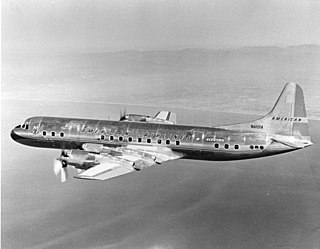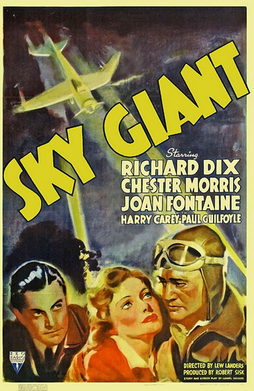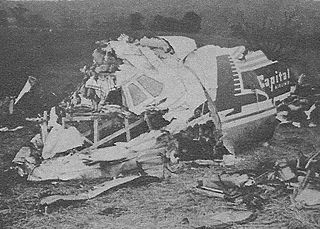The Societé anonyme belge d'Exploitation de la Navigation aérienne, better known by the acronym Sabena or SABENA, was the national airline and flag carrier of Belgium from 1923 to 2001, with its base at Brussels Airport. After its bankruptcy in 2001, SN Brussels Airlines was formed through a takeover of former subsidiary Delta Air Transport and took over part of Sabena's assets in February 2002. SN Brussels Airlines merged with Virgin Express in 2007 to form Brussels Airlines. The airline's corporate headquarters were located in the Sabena House on the grounds of Brussels Airport in Zaventem.
This is a list of aviation-related events from 1980.

The Boeing Model 247 is an early American airliner, and one of the first such aircraft to incorporate advances such as all-metal semimonocoque construction, a fully cantilevered wing, and retractable landing gear. Other advanced features included control surface trim tabs, an autopilot and de-icing boots for the wings and tailplane. The 247 first flew on February 8, 1933, and entered service later that year.

This is a list of aviation-related events from 1960.
This is a list of aviation-related events from 1970.
This is a list of aviation-related events from 1972.
New Zealand National Airways Corporation, popularly known as NAC, established by the New Zealand National Airways Act, 1945, was the national domestic airline of New Zealand until 1978 when it amalgamated with New Zealand's international airline, Air New Zealand. The airline was headquartered in Wellington.

On December 16, 1960, a United Airlines Douglas DC-8 bound for Idlewild Airport in New York City collided in midair with a TWA Lockheed L-1049 Super Constellation descending toward LaGuardia Airport. The Constellation crashed on Miller Field in Staten Island and the DC-8 in Park Slope, Brooklyn, killing all 128 aboard the two aircraft and six people on the ground. The accident was the world's deadliest aviation disaster at the time, and remains the deadliest accident in the history of United Airlines.

American Airlines Flight 320 was a scheduled flight between Chicago Midway Airport and New York City's LaGuardia Airport. On February 3, 1959, the Lockheed L-188 Electra performing the flight crashed into the East River during its descent and approach to LaGuardia Airport, killing 65 of the 73 people on board. Weather conditions in the area were poor, and the aircraft descended through dense clouds and fog. As it approached the runway, it flew lower than the intended path and crashed into the icy river 4,900 feet (1,500 m) short of the runway. American Airlines had been flying the newly-developed Lockheed Electra in commercial service for only about two weeks before the crash, and the accident was the first involving the aircraft type.

The Lockheed Model 12 Electra Junior, more commonly known as the Lockheed 12 or L-12, is an eight-seat, six-passenger all-metal twin-engine transport aircraft of the late 1930s designed for use by small airlines, companies, and wealthy private individuals. A smaller version of the Lockheed Model 10 Electra, the Lockheed 12 was not popular as an airliner but was widely used as a corporate and government transport. Several were also used for testing new aviation technologies.

American Overseas Airlines (AOA) was an airline that operated between the United States and Europe between 1945 and 1950. It was headquartered in Midtown Manhattan, New York City.

The Boeing 747SP is a shortened version of the Boeing 747 wide-body airliner, designed for a longer range. It is the highest flying subsonic passenger airliner, with a service ceiling of 45,100 feet (13,700 m). Boeing needed a smaller aircraft to compete with the McDonnell Douglas DC-10 and Lockheed L-1011 TriStar tri-jet wide-bodies, introduced in 1971/1972. Pan Am requested a 747-100 derivative to fly between New York and the Middle East, a request also shared by Iran Air, and the first order came from Pan Am in 1973.

American Airlines Flight 63 was an American Airlines DC-3 nicknamed the Flagship Missouri that crashed on October 15, 1943, near Centerville, Tennessee, after ice formed on its wings and propeller. All eight passengers and three crewmembers died. This was the second fatal crash of an aircraft designated Flight 63, occurring 2+1⁄2 months after the crash of the Flagship Missouri’s sister ship, the Flagship Ohio.

Flying Blind is a 1941 American action comedy film directed by Frank McDonald and distributed by Paramount Pictures. The film was the second movie from Pine-Thomas Productions. That company's first three films formed an unofficial "aviation trilogy"; all starred Richard Arlen.

The Lockheed L-049 Constellation was the first model of the Lockheed Constellation aircraft line. It entered service as the C-69 military transport aircraft during World War II for the United States Army Air Forces and was the first civilian version after the war. When production ended in 1946 it was replaced by the improved L-649 and L-749 Constellation.

Lufthansa Flight 502 was a scheduled flight from Hamburg, Germany to Buenos Aires, Argentina on 11 January 1959. The flight was being operated by a Lockheed L-1049G Super Constellation. On the leg between Senegal and Brazil the Super Constellation was on approach to Rio de Janeiro–Galeão International Airport when it crashed near Flecheiras Beach just short of the runway. All 29 passengers and seven of the ten crew were killed. It was the first fatal accident involving the current Lufthansa since it was formed in 1955.

Sky Giant, also known as Ground Crew and Northern Flight, is a 1938 drama film directed by Lew Landers. The film stars Richard Dix, Chester Morris and Joan Fontaine. The plot revolves around a love triangle with two pilots in love with the same woman.

Flight Into Nowhere is a 1938 American adventure film directed by Lewis D. Collins, and produced by Larry Darmour for Columbia Pictures. The film stars Jack Holt, Jacqueline Wells and Dick Purcell. In the low-budget action film, the locale of South America jungles provides an exciting venue for "flyboy" Jack Holt, who is trying to establish a new route for an American airline.

On May 20, 1958 a Vickers Viscount airliner operating Capital Airlines Flight 300 was involved in a mid-air collision with a United States Air Force T-33 jet trainer on a proficiency flight in the skies above Brunswick, Maryland. All 11 people on board the Viscount and one of the two crew in the T-33 were killed in the accident.















